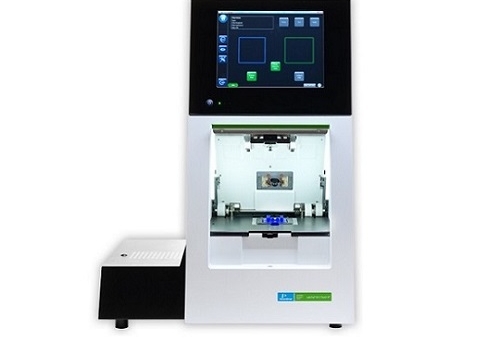
LabChip® GXII Touch™ Protein Characterization System
Analysis can be performed in as few as 42 seconds per sample
Delivering data comparable to data obtained using traditional capillary electrophoresis
A 70X increase in throughput
- Product description
- Data
- LabChip Assays
- Citations
The LabChip® GXII Touch™ protein characterization system offers an automated alternative to traditional methods by streamlining slab gel electrophoresis, while also providing the increased throughput and data quality required by biotherapeutics and genomics workflows. This flexible instrument supports multiple assays for characterizing both proteins and nucleic acids.
With the LabChip® GXII Touch™ protein characterization system, analysis can be performed in as few as 42 seconds per sample, delivering data comparable to data obtained using traditional capillary electrophoresis with as much as a 70X increase in throughput. Choose between two platforms for the greatest efficiency: a high-throughput (up to 384 samples) or lower throughput platform depending upon workflow requirements. With an easy-to-use touch screen interface, even novice users can run samples quickly.
LabChip® Electrophoresis: How Does it Work?
LabChip® electrophoresis is performed on a small, microfluidic chip. Prior to analysis, reagents are loaded into the individual wells of the chip. These wells are connected to tiny microchannels about the size of a human hair etched within the quartz microfluidic chip. When the chip is loaded into the LabChip® GXII Touch™ protein characterization system, the chip’s wells interface with platinum electrodes that provide voltage and current control. The instrument moves the microtiter plate directly under the chip’s capillary ‘sipper’, and approximately 150 nL of sample is aspirated onto the chip. Sample staining and destaining are performed automatically on the instrument platform. Individual sample analytes are separated electrophoretically and the bands detected via laser induced fluorescence in the capillaries of the chip. Sizing and concentration for each band are determined using ladder and internal markers. Rinsing the sipper between samples minimizes cross contamination.
Applications
AAV Characterization
Protein Characterization
Small Scale Protein Purification
Vaccine Development
Characterization of Asymmetric Bispecific Antibodies
Specifications
Dimensions:
| Height | Width | Depth | Weight |
| 25.75 | 19.25 | 18.25 | 54 lbs (24.5 kg) |
Plate Formats | Power Requirements | Power Consumption | Excitation/Emmission | Temperature Range | Humidity Range |
| 96- or 384-well | 100-240 Vac | N/A | 635 and 700 nm | 18-26°C | 20% - 80% RH |
Windows 10-compatible software
LabChip® GXII Touch™ Instrument Screen Simplifies Sample Analysis
User friendly operation
Load sample plate and chip
Select samples (up to 384 in a run)
Select assay type
Touch ‘Run’ to start
Automatically export data directly to your network or LIMS system
Observe runs in real time
Sample analysis in as few as 42 seconds
View electropherogram in real time during data collection
Overlay collected data to compare sample profiles
Select from various run time analytical feature annotations
See data in real time or export for later analysis
Choose “display” in E-gram, virtual gel, or data table format (Figure 1)
Pull multiple archived plates into data review or analytical comparisons
Apply data mining filter functions on key attributes
Highlight expected peaks
Track relevant user access and data history parameters with FDA 21 CFR Part 11 compatible software
The LabChip® GXII Touch™ protein characterization system operator controls are designed to allow users to easily set up and execute a run in as few as three easy steps (Figure 3). Run templates can also be imported with the operator control features. Run templates can include well selections, sample names, peak tables, which facilitate operator ease of use, and data can be automatically exported to network or LIMS directories for subsequent analysis.
Every instrument comes with a full software package for data review, allowing analysis from current or archived data sets. LabChip® GXII Touch™ and Reviewer Software contain built-in technical controls and features specifically designed to support FDA 21 CFR Part 11 regulations. These features include a shared user account database, access controls, device check, enforced sequencing of run steps, audit trails, record copying, record retention, system documentation, and electronic signature controls.
The LabChip® GXII Touch™ protein characterization system offers rapid quantification and quality control throughout biotherapeutics and genomic workflows. For example, automating the characterization process allows multiple, critical quality attributes to be obtained significantly faster. Researchers can now screen for optimal protein characteristics earlier in the process and integrate Quality by Design initiatives into their biotherapeutics development workflow (Figure 7).

Figure 1. The LabChip® GXII Touch™ protein characterization system interface offers real-time run data output and complete sample analysis.

Figure 2.Software complies with FDA 21CFR Part 11 regulations.

Figure 3. RNA Pico assay

Figure 4. Glycan Screening assay

Figure 5. Protein Charge Variant assay

Figure 6. Protein Clear HR™ assay for impurity analysis

Protein Assays
PICO PROTEIN ASSAY
PROTEIN LOW MOLECULAR WEIGHT ASSAY
EXTENDED RANGE N-GLYCAN ASSAY
GLYCAN PROFILING ASSAY
PROTEIN CHARGE VARIANT ASSAY
PROTEIN EXPRESS ASSAY
PROTEIN CLEAR™ ASSAY
PROTEINEXACT™ ASSAY
Nucleic Acid Assays
DNA 1K ASSAY
DNA 5K ASSAY
DNA 12K ASSAY
DNA HIGH SENSITIVITY ASSAY
GENOMIC DNA ASSAY
NGS 3K ASSAY
STANDARD RNA ASSAY
PICO RNA ASSAY
SMALL RNA ASSAY
Accurate Sizing, Quantification and Quality Control of Proteins
Cao, J., Perez-Pinera, P., Lowenhaupt, K., Wu, M., Purcell, O., Fuente-Nunez, C. D., & Lu, T. K. (2018). Versatile and on-demand biologics co-production in yeast. Nature Communications, 9(1). doi:10.1038/s41467-017-02587-w.
Reardon, H. T., Herbst, R. A., Henry, C. L., Herbst, D. M., Ngo, N., Cisar, J. S., . . . O’Neill, G. P. (2019). Quantification of In Vivo Target Engagement Using Microfluidic Activity-Based Protein Profiling. SLAS TECHNOLOGY: Translating Life Sciences Innovation,247263031985230. doi:10.1177/2472630319852303
Regula, J. T., Imhof-Jung, S., Mølhøj, M., Benz, J., Ehler, A., Bujotzek, A., . . . Klein, C. (2018). Variable heavy–variable light domain and Fab-arm CrossMabs with charged residue exchanges to enforce correct light chain assembly. Protein Engineering, Design and Selection,31(7-8), 289-299. doi:10.1093/protein/gzy021.
Smith, M. T., Zhang, S., Adams, T., Dipaolo, B., & Dally, J. (2017). Establishment and validation of a microfluidic capillary gel electrophoresis platform method for purity analysis of therapeutic monoclonal antibodies. Electrophoresis,38(9-10), 1353-1365. doi:10.1002/elps.201600519
Smith, M. T., Zhang, S., Adams, T., Dipaolo, B., & Dally, J. (2017). Establishment and validation of a microfluidic capillary gel electrophoresis platform method for purity analysis of therapeutic monoclonal antibodies. Electrophoresis,38(9-10), 1353-1365. doi:10.1002/elps.201600519.
Weng, Y., Ishino, T., Sievers, A., Talukdar, S., Chabot, J. R., Tam, A., . . . Lin, L. (2018). Glyco-engineered Long Acting FGF21 Variant with Optimal Pharmaceutical and Pharmacokinetic Properties to Enable Weekly to Twice Monthly Subcutaneous Dosing. Scientific Reports, 8(1). doi:10.1038/s41598-018-22456-w.








